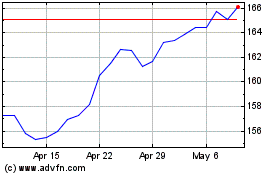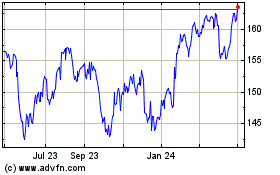Freight Costs Weighing on Earnings at Consumer-Goods Makers
April 24 2018 - 4:10PM
Dow Jones News
By Jennifer Smith
High freight costs are weighing on earnings at big
consumer-goods companies as they try to get products from soda and
toys to deodorant and household chemicals to stores.
Some companies and analysts expect the pressure on shipping,
which began late last year, to extend into the spring, when the
seasonal growth in volumes of produce, food and beverages could
place additional strain on already-tight trucking capacity.
Freight costs were up 20% from a year ago in the first quarter
at the Coca-Cola Co. North American division, the company said
Tuesday. "Like other [consumer packaged-goods] companies, we face
significant freight headwinds in North America this year," Kathy
Waller, the company's chief financial officer, said in a call
Tuesday on the company's first-quarter earnings.
Increased transportation expenses also hurt first-quarter
profits at toy maker Hasbro Inc., which said Monday it expects the
issue to persist through 2018 as shippers compete for a limited
number of available trucks.
Procter & Gamble Co. and food companies Danone SA and Nestlé
SA all cited rising freight costs in recent earnings calls, as did
lubricant-maker WD-40 Co.
"Everybody is seeing an increase," Graeme Pitkethly, chief
financial officer at Unilever PLC said in an earnings call last
week. The seller of Dove soap and Lipton tea expects U.S. freight
costs to rise by the "high-single digits to high-teens," Mr.
Pitkethly said, on higher demand and requests by retailers for more
frequent deliveries.
Manufacturers and retailers have been scrambling to book
transportation in recent months as freight volumes have expanded in
a surging U.S. economy. Bad weather, high turnover among truck
drivers and a new federal rule requiring drivers to electronically
track their hours behind the wheel have contributed to the tighter
capacity.
"It's really coming from the trucking industry and...the new
electronic logging-device rules and driver shortages," Hasbro's
chief financial officer, Deborah Thomas, said Monday. "The
contracting supply and increasing demand is expected to manifest
itself really kind of throughout 2018."
Truck capacity loosened up somewhat in February and March, which
tend to be slower shipping months. But demand was still elevated
compared to prior years, according to online freight marketplace
DAT Solutions LLC. Last month, there were 6.9 loads to be moved on
the spot truck transportation for every available dry van, the most
common type of big rig, compared to 3.2 loads in March 2017.
Freight rates also remain elevated. In March, the average rate
on the spot market for dry vans was up 32% year-over-year,
according to DAT.
Spot rates are a leading indicator of the contractual rates that
shippers set with large trucking companies. With capacity tight as
those negotiations get underway, some in the industry now expect
contract rates could increase by as much at 9.2%, according to
KeyBanc Capital Markets Inc.
At Werner Enterprises Inc., a large truckload carrier based in
Omaha, Neb., higher contract rates contributed to a 10% increase in
average revenue per total mile in the first quarter, compared to
the same period in 2017.
Demand for truckload services "was much stronger than normal for
the first quarter," Werner said in an earnings release last week.
"Freight volumes thus far in April 2018 continue to be much
stronger than normal."
Write to Jennifer Smith at jennifer.smith@wsj.com
(END) Dow Jones Newswires
April 24, 2018 15:55 ET (19:55 GMT)
Copyright (c) 2018 Dow Jones & Company, Inc.
Procter and Gamble (NYSE:PG)
Historical Stock Chart
From Aug 2024 to Sep 2024

Procter and Gamble (NYSE:PG)
Historical Stock Chart
From Sep 2023 to Sep 2024
